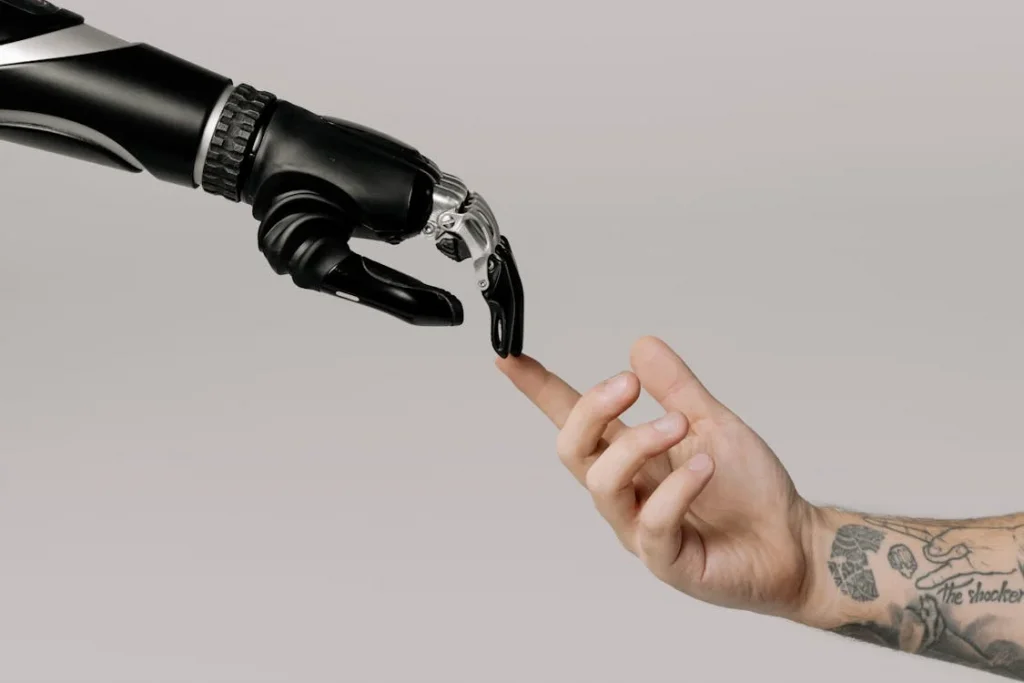Imagine submitting an academic paper edited entirely by an AI—only to have it flagged for potential plagiarism. In the rapidly evolving world of text editing, the difference between human expertise and artificial intelligence, particularly in the context of AI vs human capabilities, is becoming increasingly clear. This article explores the AI vs human effectiveness within academic publishing and beyond. We will highlight their unique strengths, inherent limitations, and why careful consideration is needed when relying on AI for critical editing tasks.
AI systems like ChatGPT offer promising capabilities and can quickly identify common errors, which might seem ideal for refining academic writing. However, the nuances of in-depth editing and the risks of breaching academic integrity suggest a more careful approach in the AI vs human debate. Furthermore, the potential for AI-generated content to be flagged by plagiarism detection tools adds another layer of complexity.
As the AI vs human dynamics continue to unfold in academic editing, understanding these aspects becomes crucial. This piece explores these issues thoroughly, seeking to provide insights into when and how to use AI effectively—and when it’s better to trust human assessment.
The unique value of human editors
While the capabilities of AI like ChatGPT are growing, human editors’ detailed and careful work is still vital. They have a sharp eye for the finer points of language that AI can’t yet match. Below you can find the unique contributions of human editors that set them apart in the AI vs human editor debate:
- Contextual mastery. Human editors have a deep understanding of context, which lets them grasp the intended meanings and subtleties of the text. Their editing guarantees that the content is not only correct in grammar but also true to the intended message. This expertise in handling context often gives them an edge over AI vs human comparison, especially when the text needs to connect and inform the audience effectively.
- Sensitivity to subtleties. Unlike AI tools like ChatGPT, human editors naturally excel at picking up and refining subtle aspects like tone, style, and cultural nuances. This careful attention to detail is critical in creative writing and academic papers, where the true spirit of the text relies on these subtle elements. In these instances, the comparison between AI and human skills highlights the human advantage in emotional intelligence and understanding of cultural context.
- Innovative problem-solving. Beyond correcting errors, human editors bring innovative problem-solving to the table. They address complex issues with creativity, an area where AI vs human capabilities split significantly. Whether it’s improving a marketing slogan or aligning academic text with scholarly standards, human editors can intuitively navigate through challenges and offer solutions that improve the impact and clarity of the text.
- Addressing the intangibles. While AI can process text efficiently, it lacks the human editor’s intuitive grasp of the intangible aspects of language—those that connect with readers on a deeper level. Humans can incorporate empathy and ethical considerations, ensuring the writing not only informs but also connects and resonates.
- Adaptability and learning. Human editors learn and adapt from each editing experience, continually refining their art. This adaptability is crucial in the evolving AI vs human landscape, ensuring that human-edited content stays dynamic and relevant.
Understanding and leveraging the unique value of human editors helps navigate the complex dynamics of AI vs human abilities in text editing. This isn’t only about choosing one over the other; it’s about recognizing when the irreplaceable human touch is needed and when AI can effectively complement those efforts.

AI vs human: Exploring the limitations of AI in editorial tasks
While AI tools like ChatGPT are becoming more advanced, they still have significant limitations that require careful consideration—particularly when compared to AI vs human capabilities in text editing. This section details the key challenges and potential pitfalls of trusting only AI for editorial tasks, especially within academic contexts.
Contextual and cultural misinterpretations
AI tools often struggle to fully understand the subtle context (the underlying meanings) and cultural nuances (local customs and idioms) within texts, which can lead to misunderstandings. This can lead to major mistakes—like getting mixed up between ‘their’ and ‘there’ or overlooking important cultural hints—that seriously change what the text is supposed to mean and lower the quality of academic writing. These errors point out a key weakness in the AI vs human editing discussion, especially in areas where using the right words is critical.
Furthermore, AI’s lack of nuanced understanding often results in texts that have a generic and robotic tone. This makes the content less engaging and removes the unique voice which is crucial in scholarly writing. The failure to capture the author’s individual style and subtle nuances meant to express complex ideas significantly weakens the effectiveness and personal touch of the text. These combined issues with language and style underscore why a thorough, human-like understanding of language and context is essential in maintaining the quality and uniqueness of academic works, highlighting the AI vs human distinction.
Challenges in domain-specific knowledge
Despite technological advances, AI tools like ChatGPT often lack in-depth expertise in specialized academic fields, a critical aspect of the AI vs. human editorial discussion. This weakness can lead to misunderstandings of crucial terminology or concepts, potentially resulting in significant errors. These errors not only mislead readers but can also misrepresent the underlying research. For instance, in technical or scientific disciplines where precision is key, even slight inaccuracies introduced by AI can drastically affect the integrity and credibility of the scholarly work. In contrast, human editors bring a nuanced understanding of these specialized fields, constantly updating their knowledge and using their expertise to ensure accuracy and reliability in academic editing. Their ability to interpret complex ideas and jargon provides a clear advantage over AI, keeping the integrity of specialized scholarly work.
Errors and bias in output
AI-generated texts often reflect the biases of their training data, which can lead to outputs that unintentionally continue stereotypes or result in inconsistent edits—major concerns in the AI vs human editorial context. In academic environments, where objectivity and fairness are important, these biases can seriously damage the integrity of scholarly work. Additionally, AI tools like ChatGPT might not manage citations and references properly, which are crucial for upholding academic integrity. Failing to cite sources correctly can greatly increase the risk of plagiarism and other related problems.
Therefore, it’s crucial for editors to strictly review AI suggestions with a tough ethical and academic perspective, ensuring that neither biases nor citation mistakes damage the quality and credibility of academic outputs. This care is essential in keeping the high standards expected in AI vs human comparisons.
Difficulty with keeping research current
The knowledge base of AI is static and only as recent as the data it was last trained on. This is a significant limitation in the dynamic field of academia where staying updated with the latest research is crucial. AI cannot automatically update its database with the latest studies. This may result in the use of outdated information, misleading readers and harming the author’s credibility. Moreover, presenting outdated facts or theories as current can result in serious academic errors that might compromise the integrity and credibility of the academic publication.
On the other hand, human editors actively keep their knowledge base by constantly engaging with new research and academic debates. This commitment ensures that their edits and recommendations are informed by the most recent advancements, keeping the academic content relevant and cutting-edge.
Limited plagiarism detection
AI’s approach to plagiarism detection typically involves matching text against a static database—a fixed set of data that doesn’t automatically update or change over time. This method significantly differs from the diverse strategies employed by human editors. This singular approach can often overlook plagiarism involving newly published materials or unpublished sources, posing serious risks in academic settings where the integrity and originality of work are crucial. The limitations of AI in identifying such cases of plagiarism highlight a critical area where human editors demonstrate excellence, reflecting the ongoing AI vs human discussion in supporting academic standards.
Lack of human-like judgment
One of the biggest drawbacks of AI tools like ChatGPT is their inability to match the detailed judgment that experienced human editors use when assessing content quality. AI systems often struggle with tasks such as judging the strength of arguments or noticing small logical mistakes—abilities that are required for detailed academic review. This limitation shows why it’s essential to have human oversight in the editing process, to confirm that the work is not only grammatically correct but also meets the highest academic standards. This important difference in the AI vs human discussion highlights the irreplaceable role of human expertise in ensuring thorough intellectual quality.
Additional limitations highlighting AI’s shortcomings
While we have already discussed significant functional limitations of AI in text editing, there are subtler yet critical areas where AI continues to fall short compared to human editors. These limitations underscore the broad spectrum of challenges that AI faces, highlighting the significant differences in capability between AI and humans in editorial tasks. Below, we explore these nuanced challenges in greater detail to further highlight the differences between AI and human editors:
- Challenges with abstract thinking. AI tools have trouble with abstract ideas and metaphors, which need a type of creative thinking and interpretation that goes beyond what they are programmed to do. This issue is especially serious in literary and philosophical works, where the use of metaphors is crucial.
- Difficulty with sarcasm and irony. Often fails to detect these subtle forms of communication, usually interpreting text just by the explicit words used. This limitation can lead to significant misinterpretations in editorial contexts, potentially changing the intended tone or message.
- Ethical reasoning limitations. Lacks the capability for ethical reasoning, crucial when editing content related to sensitive topics or under strict ethical guidelines. This could result in ethically inappropriate content.
- Emotional intelligence deficit. Unlike human editors, AI doesn’t possess emotional intelligence, essential for editing content that needs to produce specific emotions or handle sensitive topics with care.
- Adaptability and learning. Doesn’t learn from past interactions beyond pre-programmed updates and cannot organically adapt to new challenges or editorial styles, limiting its effectiveness in dynamic environments.
- Customization and personalization. AI tools typically don’t tailor their editing style to meet the specific needs of different authors or publications, unlike human editors who excel in adapting their style to fit the writer’s voice.
This deeper dive into AI’s limitations helps clarify why, despite technological progress, AI tools still support the advanced skills of human editors in the changing world of text editing.

Comparing AI vs human editing: Performance insights
After thoroughly exploring the individual strengths and limitations of AI-driven tools like ChatGPT and human editors, we now offer a clear comparison to highlight the differences in the AI vs human discussion. This comparison explores how they perform across various editing tasks. By understanding these differences, you can make informed choices about which editing resources to use, depending on the specific needs and challenges of your projects. Here’s a look at how AI vs human editors stack up in key editing areas:
| Aspect | AI-driven tools (ChatGPT) | Human editors | |
| Turnaround time | Quick responses, ideal for tight deadlines. | A slower, detailed process ensures thorough review. | |
| Error correction | Efficient at basic grammatical and some stylistic corrections. | Comprehensive corrections including grammar, style, and structure. | |
| Depth of edits | Generally superficial; lacks depth in content improvement. | Deep engagement with content; improves clarity and argumentation. | |
| Explanation of changes | Doesn’t provide reasons behind edits, limiting learning potential. | Provides detailed feedback to help writers improve. | |
| Citation integrity | Potential risk of inaccuracies in citations and quotes. | Ensures citations are accurate and appropriate, upholding scholarly standards. | |
| Cost | Typically less expensive or free. | Can be costly, reflecting the extensive and personalized service offered. | |
| Customization | Limited ability to adapt style to specific writer needs. | Edits are tailored to fit the writer’s style and preferences. | |
| Risk of biased output | May reproduce biases from training data. | Editors can critically set and eliminate bias in the text. | |
| Updating knowledge | Static knowledge base; doesn’t update with new research. | Continuously updates with the latest research and standards. | |
| Handling of nuances | Struggles with abstract concepts, sarcasm, and irony. | Capable of understanding and incorporating complex literary devices and subtleties. | |
| Ethical and emotional consideration | Limited understanding of ethics and no emotional intelligence. | Can ethically and sensitively handle delicate topics. |
The table above outlines the main strengths and limitations of AI-driven tools and human editors in the realm of text editing. While AI tools such as ChatGPT are advantageous for their speed and efficiency, they often lack the depth and nuanced understanding that human editors provide. Human editors are particularly good at tasks that need a lot of detail, custom style adjustments, and careful ethical decisions, which are very important in serious academic or creative writing. Ultimately, the choice of AI vs human editors should be based on the specific needs of the project, considering factors such as the required turnaround time, depth of editorial insight needed, and budget limitations. By leveraging the best AI vs human editing capabilities, one can achieve a high standard of text quality that meets grammatical precision and contextual richness.
As detailed earlier, while AI tools offer rapid and cost-effective solutions for initial proofreading, they often fall short of delivering the depth and nuance required for high-quality academic and creative writing. This is where our specialized document revision service comes into play. We provide comprehensive proofreading and editing by skilled human editors who guarantee that your work not only meets but exceeds professional standards. Our experts focus on detailed, custom style adjustments and supporting ethical integrity, effectively filling the gaps that AI alone cannot cover. We recommend using our human editors at Plag to achieve the highest standard of clarity and precision in your writing projects.
Practical applications and recommendations
After thoroughly analyzing the AI vs human abilities in text editing, this section offers practical advice on how to strategically use AI tools like ChatGPT alongside human editing efforts to maximize efficiency and support quality, especially in academic contexts.
Recommendations for specific scenarios
AI tools demonstrate their worth in scenarios where the unique capabilities of human editors—such as deep contextual understanding—are less critical. Examples include:
- Initial drafts. Using AI to review drafts can quickly identify and correct basic grammatical and stylistic errors. This allows human editors to concentrate on refining the text’s deeper content aspects, improving the AI vs human collaboration.
- Non-critical writings. In simpler tasks like routine emails or internal messages, AI can quickly take care of most editing work. This allows human editors to spend their time on more important or complicated projects, making the best use of AI vs human efforts.
Tips on integrating AI tools
Integrating AI tools into your editing process can greatly improve efficiency if done correctly. Here are some tips to ensure effective AI vs human integration without sacrificing quality:
- Complementary use. Employ AI tools initially to address straightforward errors, then pass the draft to a human editor for detailed review. This two-step approach helps to ensure that all nuances and contextual details are adequately addressed, making full use of AI vs human strengths.
- Set clear objectives. Define what you aim to achieve with the help of AI in your editing process. Clear goals help prevent misuse and optimize the integration of AI capabilities in scenarios that benefit most from human expertise.
- Regular reviews. It’s important to regularly check AI performance to ensure that high standards are kept in AI vs human collaborative editing projects.
Case studies
The following real-world examples highlight successful implementations of AI vs human editing collaborations:
- Academic journal case study. An academic journal used AI to quickly check initial submissions, filtering out those that didn’t meet the basic standards before the detailed peer review. This approach using both AI and human editors greatly streamlined the editing process.
- Marketing firm example. A marketing firm employed AI to draft initial content and handle routine responses. Human editors then meticulously refined this content to ensure it aligned with the brand’s high-quality standards. This effective mix of AI and human editing maximized productivity while keeping quality.

Future of editing in academic publishing
Following our in-depth review of today’s AI powers and its limitations in academic editing, we now turn our attention to the future. As AI technology advances quickly, the field of academic publishing and text editing is set for major changes. This evolution prompts a crucial review of the AI vs human roles in how editing tasks are handled in academic environments. This section delves into upcoming trends and developments in AI that might significantly change the way editing tasks are managed
Predictions on AI evolution
The capabilities of AI tools are set to grow significantly, potentially reducing the performance gap between AI and human editors:
- Advanced contextual understanding. Future AI models are likely to better grasp the context and subtleties in texts, potentially reducing the need for human involvement in complex editorial tasks.
- Improved understanding of specific subjects. AI could become better at learning and adapting to particular academic areas, providing more accurate and relevant suggestions on its own.
- Greater integration of semantic analysis. As AI improves in semantic analysis, it could provide more nuanced insights that extend beyond simple grammar and stylistic adjustments to include deeper editorial elements like argument strength and logical coherence.
Upcoming technologies in AI and machine learning
New technologies could have a big impact on academic editing:
- Natural Language Understanding (NLU) improvements. Advances in NLU are expected to improve AI’s comprehension abilities, leading to more effective revisions and corrections.
- AI-powered reference tools. Innovative tools that automatically recommend or add citations could completely change how we manage references, making them better match today’s academic rules.
- Real-time co-editing platforms. New platforms could help AI and human editors to work together on documents at the same time, which might make the editing process faster and improve teamwork.
Community response to technological changes
The academic community’s reaction to these developments involves a mix of careful optimism and proactive steps:
- Training programs. More institutions are now offering AI literacy programs to academics to help integrate AI tools effectively into their workflows.
- Ethical guidelines development. There is an increasing focus on creating ethical guidelines to manage AI’s role in academic editing responsibly.
- Collaborative research initiatives. Universities and tech companies are joining forces to develop AI solutions that meet the specific needs of academic editing and uphold the standards of scholarly work.
By understanding these potential future directions, the academic publishing community can better prepare for a landscape where AI plays a bigger and more important role. This forward-looking perspective not only anticipates changes but also helps in planning for a balanced integration of AI in academic editing processes, ensuring that both technology and human expertise are used to their fullest potential.
Conclusion
| AI tools like ChatGPT are helpful for quick text edits but lack the depth and insight only human editors provide. The AI vs human debate in academic editing highlights the crucial role of human expertise, which offers outstanding accuracy and understanding that AI cannot match. In this era of rapid technological growth, human insight stays unmatched in preparing academic writing that is compelling and ethically sound. As we delve deeper into the AI vs human dynamics, it becomes evident that professional human editors are essential. By using AI for basic tasks and humans for their deeper insights, we can achieve and surpass high academic standards. This balanced approach ensures that as technology advances, it complements rather than replaces the critical role of human expertise. |
